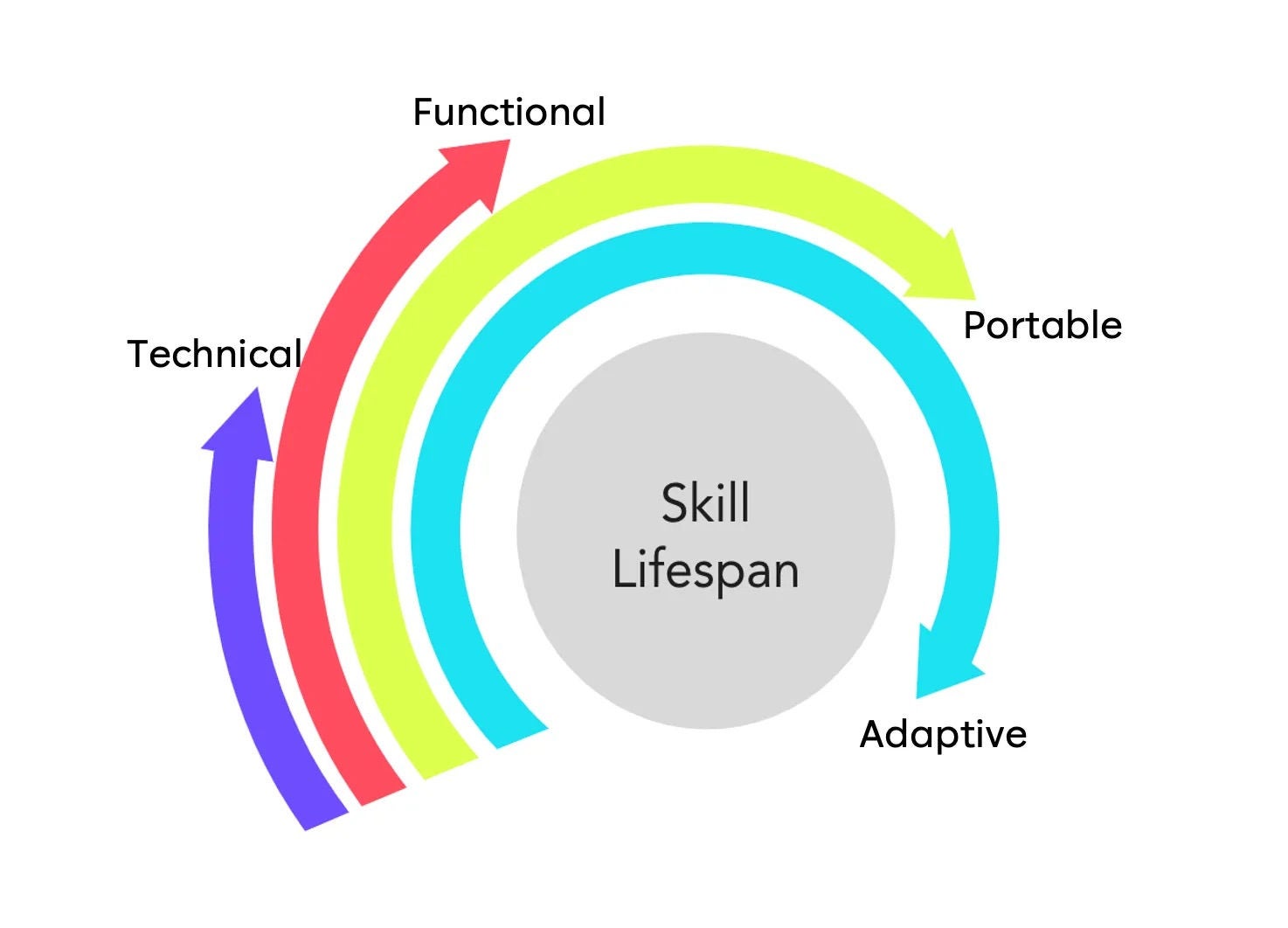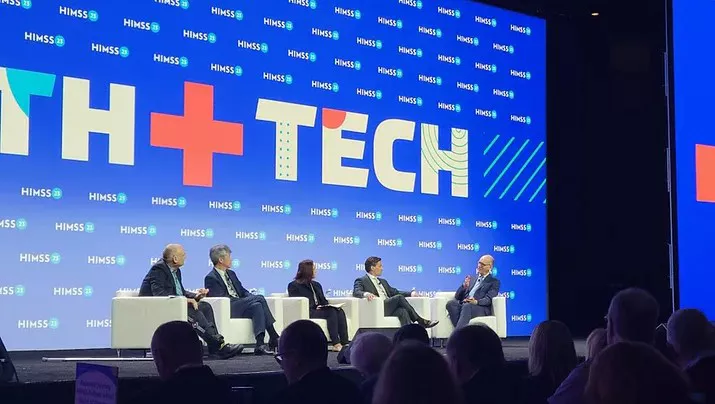Comment obtenir les compétences dont votre organisation aura besoin

It’s not an easy thing to accept that we live in a different world than we did just a few years previously. To wake up and realize that all the things we thought we knew and the skills we’ve accumulated over the past 50 years may not be as relevant anymore. But looked at in another way, it’s also very encouraging because it means the skills that humans are actually designed for are valued more now than ever.
What the skills of the past tell us about the future
Over hundreds of years, humans created new tools to build, transport, and manufacture. The technological revolution over the past 50+ years facilitated yet more evolution as computers opened up a world of information previously inaccessible. We had to learn the technology, understand its constraints, and intuit how to make it work for us. We developed new languages to interact with the computer and adapted processes to optimize its capabilities. We learned to type on keyboards to capture our thoughts and to swipe on a screen as we navigated multiple pieces of information. We adapted ourselves and the technology to help us find and analyze this information more quickly. We focused our skills on efficiency and standardization.
In the last 20 years we have needed new skills for knowledge work to collect and manage the data created through technology. We designed interfaces to make the technology accessible no matter the user’s skill level. Then we moved all this great technology from our devices to the cloud, requiring us to live in a serverless world and secure our identities. This new world required a new kind of technological fluency.
Businesses began hiring people fluent in digital technologies and created new roles and departments for them, distinguishing this type of work from traditional ways of operating. Companies shifted toward software-as-a-service, requiring employees to actively use technology for daily tasks. The focus was on training more people to utilize these new tools in ways that would improve efficiency and productivity.
There was no hiding from technology and change. Learning to use new applications was the only constant.
We learned these skills through specialized classroom learning in formal education institutions and on-the-job training. In the past, we found ourselves needing to learn how to use technology as a tool to do our jobs. Our traditional learning systems were built to teach us how to utilize technology. But today, technology is no longer just a tool we must learn to operate. It is now a dynamic mechanism that is itself learning about us.
Our future jobs will require us to leverage more of our innate human skills—using natural language, creativity, and intuition—to essentially “program” technology to work for us. The technology will need to be taught by us, using our human communication and ingenuity as the new programming language. Rather than solely learning how to use technology, we must now also teach technology, with the help of our uniquely human capabilities.
So, what does that mean for the skills we need to develop today? The ways in which our brains naturally work as humans will become our greatest assets as we navigate a consistently evolving landscape of technology capabilities.
A quartet of skills your workforce will need
If tools were paramount in the past, skills have emerged as the currency of the future. While hard skills remain essential, their shelf life is becoming progressively shorter. Innovations arrive in the blink of an eye, often rendering yesterday’s expertise obsolete. In this accelerating treadmill of progress, how does one not only keep pace but also foresee and prepare for the skills of tomorrow?
This anticipation of the future becomes even more pivotal when we recognize the impact of generative AI technologies and tools. Their emergence in the tech landscape isn’t just a testament to human ingenuity, but a challenge and opportunity to redefine how we work. AI, with its potential to autonomously generate solutions, designs, and ideas, demands a fresh approach to skill development.
Navigating this intricate tapestry of the future workplace requires a deeper dive into the “quartet of skills” that will form the bedrock of professional efficacy. Beyond the traditional realms of technical know-how and functional expertise, the emphasis is shifting toward a more holistic approach to career development and talent architectures. It’s imperative to understand these four skill categories—technical, functional, portable, and adaptive—not in isolation, but as interconnected pillars that collectively uphold the edifice of a successful career in our evolving landscape. Let’s delve into each, unraveling their essence and the pivotal role they play in ensuring resilience, adaptability, and success in the modern workforce.
Technical skills signify the knowledge required to interact with contemporary tools and technology. As our reliance on digital solutions deepens, the need for digital literacy becomes paramount. This goes beyond mere interaction; it’s about being able to design, troubleshoot, and innovate within the technological domain.
Functional skills involve a nuanced understanding of specific processes or roles. In an age where data reigns supreme, it’s not sufficient to merely collect data; one must harness it. Deep expertise in data analytics and AI, for instance, is an increasingly sought-after functional skill. As businesses rely more on prompt engineering solutions, it’s evident that the workforce lacks the depth required in these domains.

Portable skills are the universally applicable competencies that one can carry and adapt across roles, industries, and even life situations. Think of them as a multi-tool that equips you for various challenges; skills like digital proficiency, change leadership, multitasking, and customer-centricity are a few examples. For instance, an individual trained in one digital tool can easily transition to another due to their underlying understanding of digital platforms. Such portability is vital when industries merge, job roles evolve, or when entirely new roles emerge.
Adaptive skills are often dubbed as “soft skills.” Adaptive skills are anything but soft in their impact. They encompass distinctly human qualities like empathy, critical thinking, creativity, emotional intelligence, adaptability, and communication prowess. These are the bedrock skills that make collaboration, innovation, and leadership possible. In a world where AI and automation are increasingly prevalent, it’s these inherent human qualities that machines can’t replicate.
Consider the career journey of a project manager in a tech firm. Initially, their technical knowledge of specific tools and methodologies (technical skills) and understanding of the project’s workflow (functional skills) might land them the job. However, as they navigate the intricacies of their role, it’s their portable skills like multitasking and digital tool adaptability that enable them to handle multiple projects efficiently. But the real game changer? Their adaptive skills. The ability to communicate with team members, empathize with clients, think critically and creatively solve unprecedented challenges, and adapt to changing project requirements or unexpected setbacks determines their success and growth in their career.
As this project manager progresses further into the future of tech, they will inevitably encounter the burgeoning realm of generative AI technologies and tools. These sophisticated systems, capable of generating solutions, ideas, and even content autonomously, will introduce a new layer of complexity to their role. But here’s the silver lining: this AI won’t replace the project manager; instead, it will augment their capabilities.
The manager’s portable skills will be tested and enriched as they integrate these new tools into their workflows, ensuring projects benefit from AI-generated efficiencies. Meanwhile, their adaptive skills will play a pivotal role in bridging the gap between machine-generated solutions and human-centric needs. By fostering a deep understanding and synergy with generative AI, they can ensure that technology serves the project’s goals, all the while maintaining the human touch that’s integral to client relationships and team dynamics. In this AI-augmented landscape, the project manager’s combination of technical, functional, portable, and adaptive skills will solidify their position as an indispensable orchestrator of human and machine collaboration.
Bridging skill-set gaps
Technical and functional skills
Organizations should focus on continuous learning and training. Investing in upskilling programs, workshops, and certifications can help employees stay updated. Encourage a culture of curiosity, where learning and questioning are prized.
Portable skills
Mentoring and job-shadow programs can be invaluable. By pairing less experienced individuals with seasoned professionals, one can gain insights into various aspects of the business, thus enhancing their adaptability. Moreover, rotating roles or responsibilities can expose employees to different facets of the business, cultivating a broader skill set.
Adaptive skills
These are best developed through experience and reflection. Workshops on communication, leadership, team dynamics, or problem-solving can provide foundational knowledge. However, real-life application, feedback sessions, and self-reflection are crucial for honing these skills. An environment that promotes open dialogue and feedback, celebrates diverse perspectives, and values emotional intelligence can catalyze the growth of these skills.
Our journey through history reminds us that while tools and methods evolve, our intrinsic human skills remain consistently valuable. Today, as we find ourselves at the crossroads of human potential and AI’s prowess, it’s clear that the confluence of technical, functional, portable, and adaptive skills will chart our way forward.
Organizations and individuals alike must embrace this quartet of competencies, ensuring a holistic, well-rounded approach to professional development. By understanding and addressing the gaps, and by harmoniously merging the timeless human attributes with cutting-edge technology, we set the stage for a future where human-machine collaboration doesn’t just coexist but helps us thrive, heralding an era of unprecedented innovation and success.
Want to know more about how to get the skills you need for the future? Our next article in this three-part series will outline how to design the skills-based architecture your organization will need to succeed with human-machine collaboration.
This blog post was originally published here.



